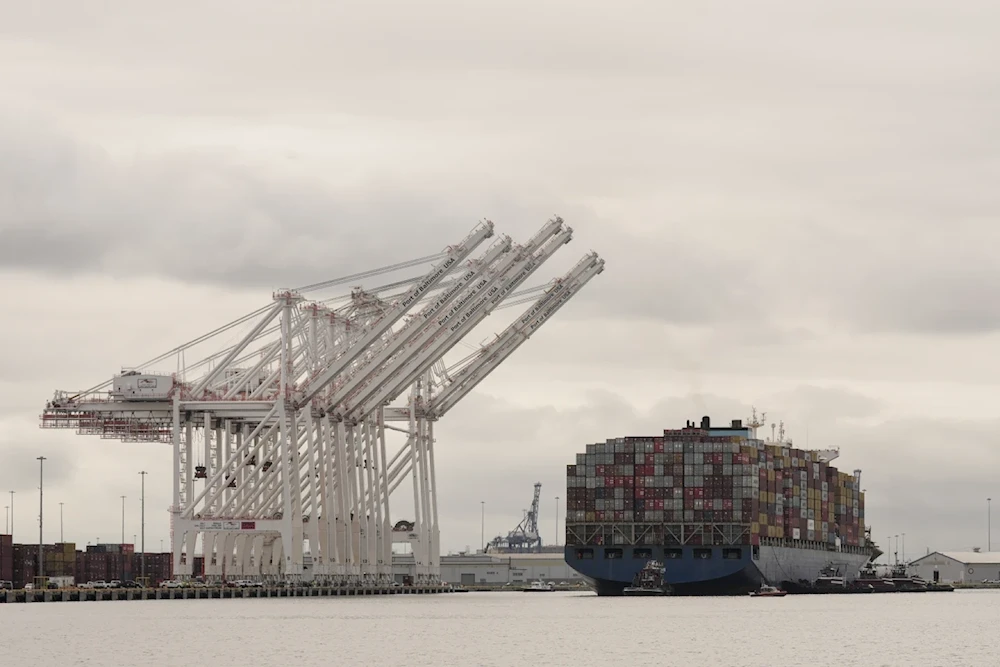Baltimore Port reopens after $100mln bridge cleanup
Officials state that companies that avoided Baltimore during the cleanup are likely to return now that the channel has been restored to its original depth and width.
-

Tugboats escorted the cargo ship Dali after it was refloated in Baltimore, on Monday, May 20, 2024. (AP)
Authorities expect commercial shipping traffic at the Port of Baltimore to return to normal soon, as the channel fully reopened earlier this week for the first time since the Francis Scott Key Bridge collapse.
“They are back open for business, ready to bring in the largest container ships that call there,” US Coast Guard Rear Admiral Shannon Gilreath said during a virtual press briefing Tuesday afternoon.
Following the deadly bridge collapse in March, some shipping companies redirected their cargo to other ports. The disaster significantly disrupted maritime traffic through Baltimore's busy port, as crews worked continuously to clear an estimated 50,000 tons of fallen steel and concrete from the Patapsco River. Officials reported that this roughly $100 million cleanup effort involved federal, state, and local agencies.
Officials also stated that companies that avoided Baltimore during the cleanup are likely to return now that the channel has been restored to its original depth and width. The city's port handles more cars and farm equipment than any other in the nation.
US Transportation Secretary Pete Buttigieg stated that all rerouted commercial traffic "belongs in Baltimore today." He noted that there are clear signs of this happening and emphasized that the expectation will be reinforced in discussions with supply chain stakeholders.
Crews have been able to reopen portions of the deep-draft channel in phases, allowing some commercial traffic to resume in recent weeks. Officials reported that some cruise ships and large container ships have already passed through.
'$2 billion reconstruction'
Officials have indicated that rebuilding the bridge could cost nearly $2 billion, with hopes for completion by 2028.
The Biden administration approved $60 million in immediate federal aid, which Buttigieg described as “a down payment on the work ahead.” White House Deputy Chief of Staff Natalie Quillian confirmed that all of this aid has been allocated.
Biden also committed to having the federal government cover the entire cost of rebuilding the bridge, although the funding is still pending approval from Congress.
On Tuesday, Biden issued a statement commending everyone involved in the recovery efforts.
“Baltimore can count on us to stick with them every step of the way, and we will continue to have your back until the bridge is rebuilt,” he said.
In the early hours of March 26, the cargo ship Dali collided with a critical support column of the Francis Scott Key Bridge, causing the span to collapse and sending six members of a roadwork crew to their deaths.
The ship had lost power shortly after departing Baltimore for Sri Lanka. A National Transportation Safety Board investigation revealed that the ship had experienced power outages before starting its voyage, but the exact causes of the electrical issues remain undetermined. Additionally, the FBI is conducting a criminal investigation into the circumstances leading up to the collapse.
The Dali remained trapped amid the wreckage for nearly two months, with a massive steel truss draped across its damaged bow. On May 20, the ship was refloated and guided back to port, allowing officials to open a channel 50 feet (15 meters) deep and 400 feet (122 meters) wide, sufficient for most of the largest commercial vessels.
The full federal shipping channel is 700 feet (213 meters) wide. Officials stated that two-way traffic can now resume with the channel's reopening. They also noted that additional safety requirements have been lifted due to the increased width.
Read next: Ship that crashed into Baltimore bridge had 'power issue:' Official

 4 Min Read
4 Min Read








